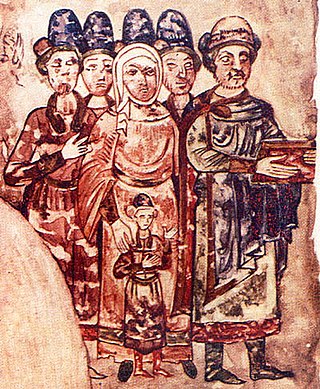Related Research Articles
Lothair is a Germanic given name, derived from the older form Clotaire (Chlotharius).

The Northern March or North March was created out of the division of the vast Marca Geronis in 965. It initially comprised the northern third of the Marca and was part of the territorial organisation of areas conquered from the Wends. A Lutician rebellion in 983 reversed German control over the region until the establishment of the March of Brandenburg by Albert the Bear in the 12th century.
Lothair I was Margrave of the Nordmark from about 983 until his death. He was also a member of Saxon nobility as Count of Derlingau and of Nordthüringgau.
Lothair Udo II was Margrave of the Nordmark from 1057 until his death and also Count of Stade. He was the only son of Lothair Udo I of the Udonids and Adelaide of Rheinfelden.

Liudolf of Brunswick was Margrave of Frisia, Count of Brunswick, Count in the Derlingau and the Gudingau.
Richenza was a German noblewoman. By her first marriage, she was Countess of Werl. By her second marriage, she was Countess of Northeim, and from 1061 to 1070, Duchess of Bavaria.

The Counts of Stade were members of the Saxony nobility beginning in the 10th century. Stade had developed since the 8th century as a principal center of trade and communications. The Counts of Stade created their domain between the lower Elbe and Weser rivers. They extended their power northwards with the acquisition of Dithmarschen in the 11th century. They became the Margraves of the Nordmark in 1056. There is also a close political and familial relationship between the Counts of Stade and the Counts of Walbeck. The Northern March was replaced with the March of Brandenburg by Albert the Bear in the 12th century. The family of Counts of Stade is referred to as the House of Udonids.
Henry I the Bald was Count of Stade. He was son of Lothar II, Count of Stade, and Swanhild of Saxony. Henry is recorded as a cousin of Otto I, Holy Roman Emperor, but their exact relationship remains a mystery. Henry was also appointed Count of Heilangau, the ancient capital of Stade, in 959.
Lothair Udo I, Count of Stade, son of Henry I the Bald, Count of Stade, and his wife Judith von der Wetterau, granddaughter of Gebhard, Duke of Lorraine. Lothair is frequently confused with his nephew Lothair Udo II, son of his brother Siegfried II, who was Margrave of Nordmark as Lothair Udo I.
Siegfried II, Count of Stade, was the youngest son of Henry I the Bald, Count of Stade, and his wife Judith von der Wetterau, granddaughter of Gebhard, Duke of Lorraine. He succeeded his brother, Henry as Count of Slade in 1016.
Lothar II the Elder, Count of Walbeck, son of Lothar I, Count of Walbeck.
Henry I the Long, Margrave of the Nordmark, also Count of Stade, son of Lothair Udo II, Margrave of the Nordmark, and Oda of Werl, daughter of Herman III, Count of Werl, and Richenza of Swabia.
Lothair Udo III (1070-1106), Margrave of the Nordmark and Count of Stade, son of Lothair Udo II, Margrave of the Nordmark, and Oda of Werl, daughter of Herman III, Count of Werl, and Richenza of Swabia. Brother of his predecessor Henry I the Long.
Rudolf I, Margrave of the Nordmark and Count of Stade, son of Lothair Udo II, Margrave of the Nordmark, and Oda of Werl, daughter of Herman III, Count of Werl, and Richenza of Swabia. Rudolf was the brother of his predecessors Henry I the Long and Lothair Udo III.
Helperich (Helferich), Count of Plötzkau and Walbeck, and Margrave of the Nordmark, son of Dietrich, Count of Plötzkau, and Mathilde von Walbeck, daughter of Conrad, Count of Walbeck, and Adelheid of Bavaria. The count's sister Irmgard was married to Lothair Udo III, Margrave of the Nordmark, and was the mother of Helperich's successor in ruling the margraviate, Henry II.
Henry II, Margrave of the Nordmark, also Count of Stade, son of Lothair Udo III, Margrave of the Nordmark, and Irmgard, daughter of Dietrich, Count of Plötzkau, and Mathilde von Walbeck.
Udo IV, Margrave of the Nordmark and Count of Stade and Count of Freckleben, son of Rudolf I, Margrave of the Nordmark, and Richardis, daughter of Hermann von Sponheim, Burgrave of Magdeburg. It is unclear why he went by the abbreviated name of Udo as opposed the traditional Lothair Udo of his ancestors.
The Udonids (Udonen) were a German noble family, ruling as both the Counts of Stade and Margraves of the Nordmark, or Northern March, from the 9th to the 12th century. The first formal member of this family was Henry I the Bald, who took his seat in Harsefeld, part of the Duchy of Franconia, where he built a castle in 965. He was the grandson of the first Count of Stade, Lothar I, who was killed by the Great Heathen Army in the Battle of Ebstorf, and was recognized as one of the Martyrs of Ebsdorf by the Catholic Church.
Dietrich, Count of Plötzkau', son of Bernhard I von Kakelingen, Count of Harzgau and his wife Ida of Querfurt. Little is known about Dietrich or his ancestors other than their familial relations. Dietrich was the brother of Gebhard of Supplinburg, a Saxon count, who was the father of Lothair II, Holy Roman Emperor. Ida, the mother of Dietrich, was niece of Saint Bruno of Querfurt.

Oda of Stade was a German noblewoman, who was the daughter of Ida of Elsdorf. Through marriage to Sviatoslav II of Kiev, she became a Grand Princess consort of Kievan Rus'.